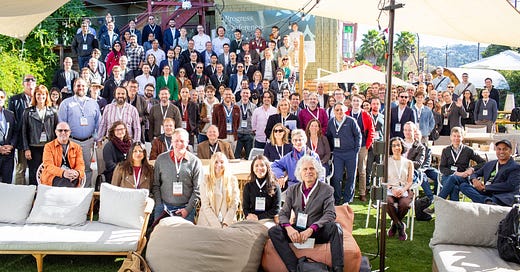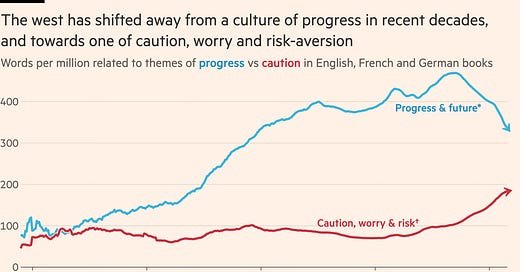

Discover more from The Free Market Futurist
In the first installment of this series, I described the emergence of a “Third Industrial Revolution” set off by the increasing integration of computers, the Internet, and information technology with manufacturing. Technology that up now has mostly been used to transmit and process information is increasingly being used to move things and make things.
I mentioned that this is connected to a revolution in robotics. If computers and information technology are the brain of this new industrial system and computer networks like the Internet are the nervous system, then the system needs eyes and ears—and it needs legs and hands.
Mechanization is not a new phenomenon. Replacing human effort with the work of machines was the essential achievement of the first Industrial Revolution. More recently, the revolution in electronics and computing has produced relatively simple robots mostly used in large industrial operations, such as the robots used for painting and welding in automobile factories.
But these have generally been large, expensive machines customized for very specific tasks. Today, the robots are getting smaller, less expensive, more agile, more versatile—and more like humans.
This has big implications. In the not-too-distant future, virtually any physical task that can be performed by a human will be able to be performed by a machine. And soon after that, robots will be able to do these things faster and more reliably, and to work longer hours.
In other words: Anything you can do, iCan do better.
If you don't have Ethel Merman singing in your head right now, let me help you out with that. You can thank me later.
One of the most important of these new robots doesn't look like a robot. It looks like your car.
By now, you may have seen the video of Google’s driverless car chauffeuring a blind man around town. The Google car operates through a series of cameras and sensors, but one city is also testing a system in which all cars are equipped with “V2V” (vehicle-to-vehicle) transponders that let them “talk” to one another, communicate information about position, acceleration, and braking, and co-ordinate their actions in traffic. So the Internet of Things will include an Internet of Cars.
The driverless car is still a long way from making it to the road.
For now, at least, the car only drives routes it’s been trained to drive. My ride in Washington, DC, was along a route that Google engineers had driven with the car earlier. Google refused to allow the car to be driven anywhere beyond this well-studied environment, at least not with the media tagging along.
Still, that doesn’t mean it was a cake walk.
No Google engineer taught the car that a bunch of kids on a field trip would march out in front of it at an intersection. It stopped and waited for them on its own. And no one told it that, right after that, another car would run the four-way stop sign right in front of it. It handled that, too, avoiding a collision all on its own.
At first, those interactions seemed boringly normal to me until I remembered...no one was driving! The car had done that all itself while the man in the driver’s seat sat passively watching.
One major hurdle is the cost of the “lidar” (light detection and ranging) system that serves as the car’s eyes. Google's version costs $75,000 apiece—but then again, it is totally new and isn’t mass-produced. Look for that price to go down dramatically.
In fact, aspects of driverless technology have already been introduced, such as “adaptive cruise control,” which automatically slows down your car when the cars in front of you slow down. The general consensus is that cars are already going driverless by degrees, introducing more of this technology a bit at a time and billing them as safety features that supplement the work of a human driver—until eventually he will have no work to do.
It's not just Google that’s working on this. It’s GM and Audi and Mercedes and Toyota. An engineer at Ford says, “There is no technology barrier from going where we are now to the autonomous car. There are affordability issues, but the big barrier to overcome is customer acceptance.”
I don't think that will be much of an issue. As someone who lives in a semi-rural area, I spend a lot more time driving than I would like, and I would jump at the chance to get some of that time back—being able to work while driving to a meeting, or to read to my kids while the car drives us to school, and so on.
Imagine the other advantages: mobility for the blind and for the elderly, a decrease in accidental deaths from fatigue (one of the leading causes of fatal accidents) and intoxication. A drunk leaving the local bar can pour himself behind the wheel and sleep it off while the car takes him safely home.
An autonomous vehicle’s driving habits can also be optimized for fuel efficiency, and the driverless car is the technology that may finally make electric cars into a practical means of transportation. The idea is that electric cars can be used as automated taxis in big cities, whisking customers around on short trips that are well within battery range, then returning to their charging stations between fares. The task of battery management, which makes long-range trips in electric vehicles so annoying, can be taken care of by machines. As Jack Wakeland pointed out to me, one of the big advantages of electric cars is “Zero air pollution in congested cities. The long tailpipe”—going from your electric car charger back to a coal-fired power plant—“takes the exhaust gas far out into the countryside and puts it out of a 500-ft. stack for broad diffusion. Dilution is the solution to pollution. This may sound ‘environmentalist,’ but that is not the way I mean it. I’m just old enough to remember how the air would burn the lungs and sting the eyes on a stagnant summer afternoon in Chicago. I remember the stone buildings of the world’s great cities all turned black by corrosive gases formed by the photo-chemical reactions of unburned hydrocarbons in auto exhaust.”
And surprisingly few people are discussing what might be the biggest economic application of driverless technology: long-haul trucking. Imagine long “trains” of driverless trucks that can go from East Coast to West Coast without stopping, and then turn right back around.
All told, one economist estimates that driverless car technology is going to become a multi-trillion-dollar business.
Just in the US, the car puts up for grab some $2 trillion a year in revenue and even more market cap. It creates business opportunities that dwarf Google’s current search-based business and unleashes existential challenges to market leaders across numerous industries, including car makers, auto insurers, energy companies, and others that share in car-related revenue.
But of course, the most compelling stories are about the robots that look like us. Engineers are developing robots that can walk, climb stairs, or run really fast.
Then there are humanoid robots that play soccer. It may seem like a trivial application, but what better proving ground is there for designing robots that are agile, responsive, and able to detect and react to what's going on around them? In fact, there is already a Robocup robot soccer competition.
The robots still need a fair bit of training, inspiring a hilarious video combining footage of the Robocup with some rather overheated sports announcers from a real, human soccer game.
Laugh if you like. But then again, how long did it take for a computer to beat a human at chess, or at “Jeopardy”? If those computational tasks could be overcome, the computational tasks of walking, running, and kicking a ball can be mastered, too.
These experiments are with humanoid robots, but there is a vigorous debate on the merits of legs vs. wheels. And then there are robot that do without either: the quadrotors—small helicopters with four rotors, which makes them both stable and extremely maneuverable.
Swarms of autonomous quadrotors can build walls out of blocks or build structures out of modular beams. Or they can be programmed to throw and catch poles.
So far, all of this has about as much economic value as the soccer-playing robots—but they are being used to prove basic concepts for more practical applications. The only commercial application I know of so far is the Joggobot, which is supposed to accompany you when you go running. And then there is the Tacocopter—a fake ad for a business that supposedly allows you to order up a fast-food taco on your smartphone and have it delivered by an autonomous quadrotor drone.
Again, laugh if you like. But in ten years, this—or a self-driving car—is how your pizza delivery might arrive. It certainly has advantages over the usual method.
Some of these ideas may be, shall we say, a bit ahead of their time. But there is already a growing private market in commercial drones. One of the biggest markets is agricultural.
“A manned crop sprayer is flying 10 feet above his crops—how accurate is it? Any crop you spray that isn’t on your farm you have to pay for, and a remote-controlled ‘copter can be very precise,” Mailey says. “Spraying, watering—there’s a whole market for precision agriculture, and when you put that cost-benefit together, farmers will buy [drones].”...
Companies like CropCam build lightweight, modular, GPS-driven gliders to give farmers an aerial view of their fields without requiring pilot training or the expense of buying a small manned plane....
Japan also provides some indication of the potential demand for drones by farmers. Yamaha introduced its RMAX unmanned helicopter for crop-spraying in 1990. By 2010, the drone ‘copter and its robotic competitors—some 2,300 of them—sprayed 30 percent of Japanese rice fields with pesticides, according to a recent Yamaha presentation.
Another use of drones is for aerial cameras for sporting events or recreation. One drone entrepreneur describes the development of the business by analogy to the early days of the PC: “We’re past the Apple II, and we’re kind of closing in on the Mac.”
And we’re just getting started. Speaking of agriculture, there’s the autonomous winebot built to tend to vineyards. There are dexterous robots designed “to perform such delicate tasks as assembling smartphones—something now typically done by nimble-fingered women in China.” Then there are robot noodle chefs.
Much higher-skilled labor is also being replaced by machines, including robot surgeons. Oh, and did I mention IBM’s Watson, which beat humans on the “Jeopardy” quiz show? Now IBM is sending Watson to medical school—appropriately enough, given its namesake—and filling its databases with the information necessary to make medical diagnoses. That sums up the progression from an expensive and elaborate toy to a powerful practical tool. If it is happening to a quiz-show computer, it will happen to soccer-playing robots and acrobatic drones.
When it comes to our new jobs as futurists, the usual disclaimers apply. Some of these robots are more flash than technology. (The noodle chefs are really just glorified windshield wipers.) Some of them still have big technological hurdles to overcome, and many have no immediate commercial application. Then again, as with steam engines and automobiles and computers, there will also be many new applications for the new robots that we cannot even imagine ahead of time.
To understand what is coming, you have to understand the implications of Moore’s Law. Here’s a good explanation:
One of the laws in action when it comes to technology is Moore’s Law, that the computing power that can fit on a microchip doubles just under every two years or so. It has become an encapsulation of broader exponential trends in technology that have occurred through history, with technology constantly doubling upon itself in everything from power to storage to broader innovation patterns. If Moore’s Law holds true over the next 25 years, the way it has held true over the last 40 years, then our chips, our computers, and, yes, our robots will be as much as a billion times more powerful than today....
The bottom line is that what was once only fodder for science-fiction conventions like Comic-Con is now being talked about seriously in places like the Pentagon. A robotics revolution is at hand.
At the pace of change implied by Moore’s Law, the (literally) stumbling efforts of today’s robot soccer athletes will quickly be solved, if only by the application of ever greater computing power. Robot technology that was impossible a few years ago and is inadequate now will soon become feasible, then reliable, then highly advanced—and soon robots will be doing many tasks that are no longer trusted to slow, clumsy, inconsistent humans.
About a year and a half ago, I warned that “We Are All Expendable Now,” that information technology is already beginning to replace many forms of skilled white-collar labor. As information technology become more fully integrated with transportation and manufacturing, look for robots to replace many forms of skilled blue-collar labor, too.
We can debate the social and economics implications of this next stage of the Industrial Revolution—some of which are the opposite of what you might expect, as I will discuss in the next installment of this series. But we can only adjust to this new wave of innovation. We cannot stop it. The technology is already here, and the economic incentives for developing are too great.
So keep humming this tune in the back of your mind: Anything you can do, iCan do better.
Subscribe to The Free Market Futurist
Celebrating and liberating innovation.










